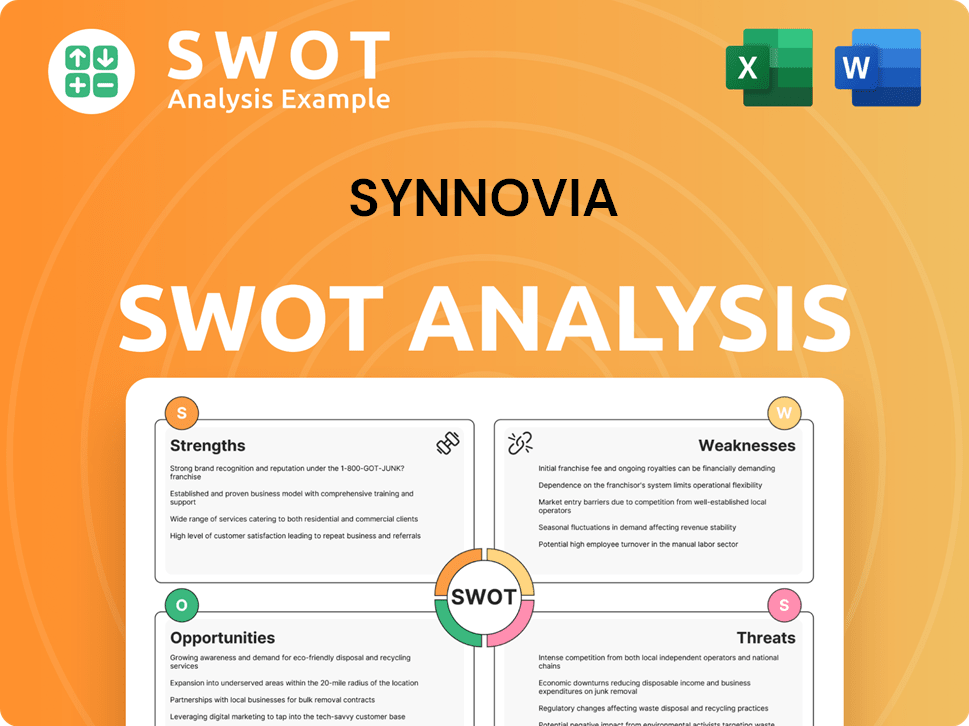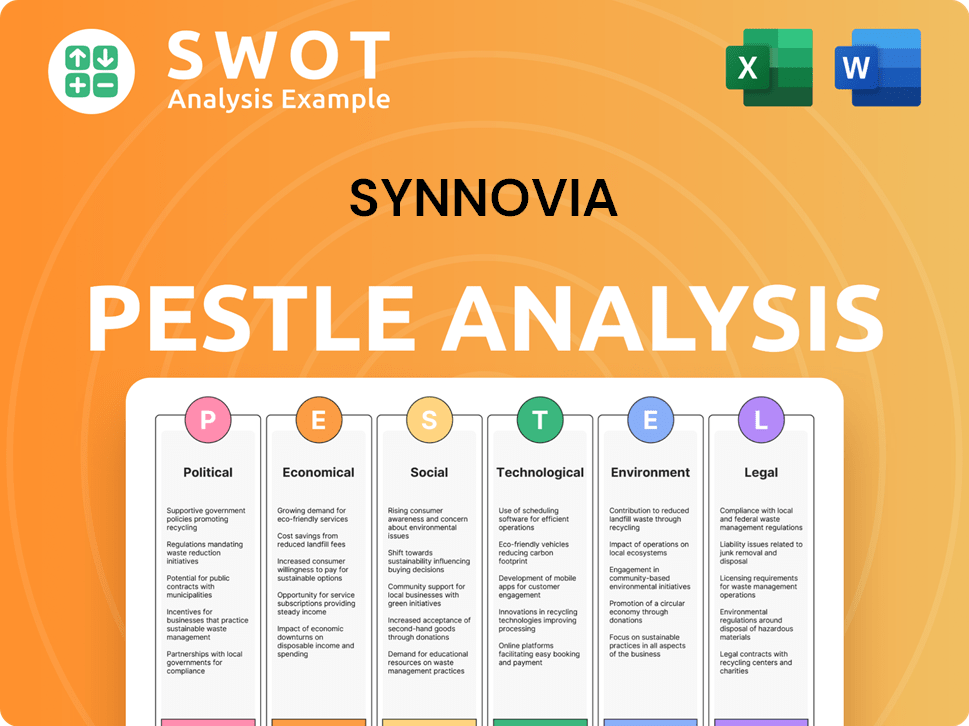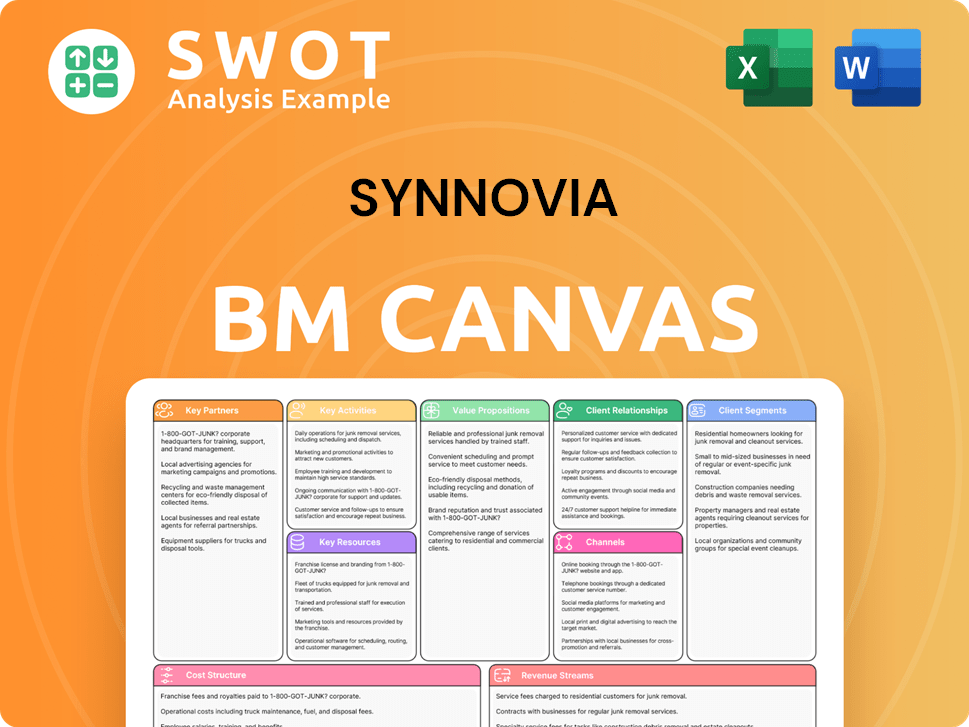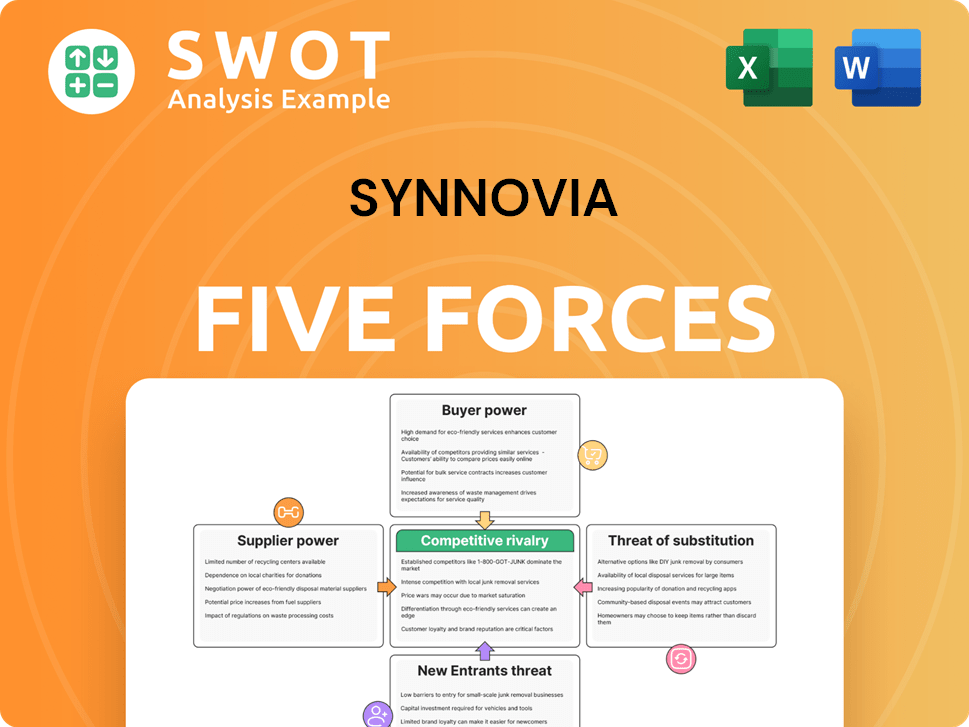Synnovia Bundle
Who Really Owns Synnovia?
Unraveling the Synnovia SWOT Analysis reveals more than just market positioning; it spotlights the core of its operations: its ownership. Understanding the ownership structure of Synnovia is paramount for anyone looking to assess its future potential, especially given the company's significant presence in the healthcare sector. The company's strategic direction and financial stability are deeply intertwined with the hands that control it.

The 2019 takeover by Camelot Capital Partners fundamentally shifted the Synnovia ownership landscape, making it crucial to examine the current major stakeholders and their influence. This exploration will provide insights into the Synnovia company owner, the Synnovia management, and the Synnovia leadership, shedding light on how these factors affect the company's trajectory and its ability to navigate the complexities of the market. Furthermore, we'll delve into the Synnovia company financial information and other key aspects.
Who Founded Synnovia?
The entity now known as Synnovia Limited was initially established on October 2, 2007, under the name Plastics Capital Trading PLC. This marked the beginning of a journey that would see the company evolve through strategic acquisitions and market adjustments. The company's formation was geared towards acquiring Plastics Capital Trading Limited, setting the stage for its entry into the plastics products market.
While the specific founders and their initial equity distribution aren't publicly detailed, the company's early structure was designed to facilitate growth. Upon its admission to the AIM on December 3, 2007, the management team retained approximately 33% of the share capital. This structure aimed to align the interests of the management with those of other shareholders, fostering a collaborative approach to the company's development.
The early backing of Synnovia included a strong group of institutional and private client investors, which played a crucial role in its initial capitalization. The company's strategy from the outset involved significant acquisition activity to expand its market presence and capabilities.
The IPO on the AIM market provided the company with essential capital for its expansion plans. The net cash proceeds from the IPO amounted to £16.2 million, demonstrating early investor confidence.
Octopus Investments was an early supporter of the company. Chris Allner, representing Octopus Investments, served on the board, contributing to the company's early strategic direction.
The company's strategy included an aggressive acquisition plan to boost its market position. In the year ending March 31, 2008, Synnovia completed four acquisitions to expand its portfolio.
The management team held approximately 33% of the share capital after the AIM admission. This ownership structure was designed to ensure that the management's incentives were aligned with those of the other shareholders.
The funds raised from the IPO were primarily allocated to debt reduction and supporting the company's acquisition program. This strategic allocation was aimed at strengthening the company's financial position and facilitating growth.
The acquisitions of Cobb Slater Limited, Sabre Plastics Limited, Channel Matrix Limited, and GKT Partnership Limited (including its subsidiary Palagan Limited) were key early moves. These acquisitions were pivotal in expanding Synnovia's market footprint.
The early ownership structure and strategic decisions set the foundation for Synnovia's growth. The initial focus on acquisitions and the alignment of management and shareholder interests were crucial elements in its early success. For a deeper understanding of the company's strategic direction, consider reading about the Growth Strategy of Synnovia.
Synnovia SWOT Analysis
- Complete SWOT Breakdown
- Fully Customizable
- Editable in Excel & Word
- Professional Formatting
- Investor-Ready Format

How Has Synnovia’s Ownership Changed Over Time?
The evolution of Synnovia's ownership has been marked by a significant transition. Initially a public entity listed on AIM as Plastics Capital PLC, the company later became privately held. A pivotal moment occurred in 2019 when Camelot Capital Partners LLC, an investment management firm, initiated a takeover bid. This led to Camelot, through its subsidiary BPF1 Ltd, acquiring Synnovia for 125 pence per share, effectively taking the company private. Prior to the acquisition, Camelot held a 29.9% stake through Barker Partnership LP.
The acquisition, finalized on November 12, 2019, involved Camelot acquiring the remaining 70.1% stake for £35.6 million. This restructuring transformed Synnovia into a private equity-backed company. This shift in ownership is a key aspect of understanding who owns Synnovia and how the company is managed. The Brief History of Synnovia provides further context.
| Event | Date | Details |
|---|---|---|
| Takeover Offer by Camelot Capital Partners LLC | 2019 | Recommended £48.8 million offer for Synnovia PLC. |
| Acquisition Completion | November 12, 2019 | BPF1 Ltd, a Camelot subsidiary, acquired Synnovia for 125 pence per share. |
| Ownership Structure Change | November 2019 | Synnovia transitioned from a public to a private company. |
As of recent reports, Synnovia Limited has three listed shareholders and one Person with Significant Control (PSC). The ultimate parent entity is Plastics Capital Trading Ltd., with Plastics Capital Ltd. identified as having significant control. The company's financial statements for the year ended March 31, 2024, reflect the board's confidence in improving profitability following a restructuring. Net debt decreased by £3.6 million from £14.6 million at March 31, 2023, to £11.0 million at March 31, 2024, partly due to the replacement of third-party debt with shareholder loans. This financial data provides insights into the company's current standing and future prospects.
Synnovia ownership has shifted from public to private equity-backed. This change was driven by a takeover bid in 2019 by Camelot Capital Partners LLC.
- Camelot Capital Partners LLC acquired Synnovia in 2019.
- Plastics Capital Ltd. has significant control.
- The company is focused on improving profitability.
- Net debt decreased by £3.6 million in the year ended March 31, 2024.
Synnovia PESTLE Analysis
- Covers All 6 PESTLE Categories
- No Research Needed – Save Hours of Work
- Built by Experts, Trusted by Consultants
- Instant Download, Ready to Use
- 100% Editable, Fully Customizable

Who Sits on Synnovia’s Board?
As of the financial statements for the year ended March 31, 2024, the board of directors for Synnovia Limited includes G Clark, F Rahmatallah, W Barker, C Andersson, J Wilkinson, and A Green. Georgina Stephanie Clark serves as a Director and Finance Director. Faisal John Rahmatallah is the Chairman, appointed on October 9, 2007. William Jack Barker is a Director and the founder and CEO of Camelot Capital Partners LLC. Anthony Green, Carl Andersson, and J Wilkinson also serve as directors. Understanding the Synnovia ownership structure is key to grasping its operational dynamics.
The board's composition reflects a mix of financial expertise and strategic leadership, crucial for guiding the company's direction. The presence of the Chairman and the Finance Director, along with the CEO of Camelot Capital Partners, highlights the influence of key stakeholders in the decision-making process. This structure supports the company's strategic goals within the healthcare sector. Analyzing the Synnovia management and Synnovia leadership is essential for investors and stakeholders.
| Director | Title | Notes |
|---|---|---|
| G Clark | Director, Finance Director | |
| F Rahmatallah | Director, Chairman | Appointed October 9, 2007 |
| W Barker | Director | Founder and CEO of Camelot Capital Partners LLC |
| A Green | Director | |
| C Andersson | Director | |
| J Wilkinson | Director |
Given its status as a privately held entity backed by private equity, the voting power within Synnovia is primarily concentrated with Camelot Capital Partners and associated entities. The acquisition by Camelot Capital Partners, which involved gaining control through a majority stake, indicates a consolidated voting structure under their influence. While specific details on voting rights, such as dual-class shares, are not publicly available, the ownership structure reflects a unified strategic direction under the current ownership. For more insights, you can explore the Competitors Landscape of Synnovia.
The board of directors plays a crucial role in guiding Synnovia's strategic direction. The leadership team, including the Chairman and Finance Director, steers the company's financial and operational strategies. The influence of Camelot Capital Partners significantly shapes the company's governance and strategic decisions.
- The board includes key figures from Camelot Capital Partners.
- Voting power is concentrated with Camelot Capital Partners.
- The company's strategic direction is unified under the current ownership.
- The board's composition supports the company's strategic goals within the healthcare sector.
Synnovia Business Model Canvas
- Complete 9-Block Business Model Canvas
- Effortlessly Communicate Your Business Strategy
- Investor-Ready BMC Format
- 100% Editable and Customizable
- Clear and Structured Layout

What Recent Changes Have Shaped Synnovia’s Ownership Landscape?
In the past few years, the ownership of Synnovia has remained with Camelot Capital Partners LLC, which acquired a 70.1% stake in November 2019. This shift to private ownership has allowed for a long-term strategic approach. This contrasts with the challenges of public markets that the previous independent directors faced.
The company experienced financial adjustments, including a decrease in sales volume between October 2022 and August 2023, attributed to economic conditions. In response, Synnovia underwent restructuring in FY2024 (ending March 31, 2024). Despite a 15.5% decrease in turnover, adjusted EBITDA increased. Net debt also decreased by £3.6 million in FY2024.
| Key Financial Data (FY2024) | Value | Change from FY2023 |
|---|---|---|
| Turnover | £75.6 million | -15.5% |
| Adjusted EBITDA | £2.26 million | Increase |
| Net Debt | £11.0 million | -£3.6 million |
Leadership changes included the appointment of C Andersson as a director in February 2024. The sale of assets by a subsidiary and the achievement of carbon neutral status for FY2024 are notable developments. For more information on the company's business model, you can read Revenue Streams & Business Model of Synnovia.
Camelot Capital Partners LLC currently owns Synnovia. The transition to private ownership allowed for a long-term strategic approach. This shift has influenced the company's operational and financial strategies.
Synnovia experienced a decrease in turnover in FY2024. Despite this, adjusted EBITDA increased, and net debt decreased. The company's restructuring efforts were a key part of adapting to the changing economic conditions.
There have been changes in the Synnovia leadership team. A subsidiary's asset sale and the achievement of carbon neutrality highlight strategic adjustments. These moves reflect the company's response to market dynamics.
Faisal Rahmatallah is still noted as the Chairman of Synnovia. William Barker is the founder and CEO of Camelot Capital Partners LLC. C Andersson was appointed as a director on February 19, 2024.
Synnovia Porter's Five Forces Analysis
- Covers All 5 Competitive Forces in Detail
- Structured for Consultants, Students, and Founders
- 100% Editable in Microsoft Word & Excel
- Instant Digital Download – Use Immediately
- Compatible with Mac & PC – Fully Unlocked

Related Blogs
- What are Mission Vision & Core Values of Synnovia Company?
- What is Competitive Landscape of Synnovia Company?
- What is Growth Strategy and Future Prospects of Synnovia Company?
- How Does Synnovia Company Work?
- What is Sales and Marketing Strategy of Synnovia Company?
- What is Brief History of Synnovia Company?
- What is Customer Demographics and Target Market of Synnovia Company?
Disclaimer
All information, articles, and product details provided on this website are for general informational and educational purposes only. We do not claim any ownership over, nor do we intend to infringe upon, any trademarks, copyrights, logos, brand names, or other intellectual property mentioned or depicted on this site. Such intellectual property remains the property of its respective owners, and any references here are made solely for identification or informational purposes, without implying any affiliation, endorsement, or partnership.
We make no representations or warranties, express or implied, regarding the accuracy, completeness, or suitability of any content or products presented. Nothing on this website should be construed as legal, tax, investment, financial, medical, or other professional advice. In addition, no part of this site—including articles or product references—constitutes a solicitation, recommendation, endorsement, advertisement, or offer to buy or sell any securities, franchises, or other financial instruments, particularly in jurisdictions where such activity would be unlawful.
All content is of a general nature and may not address the specific circumstances of any individual or entity. It is not a substitute for professional advice or services. Any actions you take based on the information provided here are strictly at your own risk. You accept full responsibility for any decisions or outcomes arising from your use of this website and agree to release us from any liability in connection with your use of, or reliance upon, the content or products found herein.